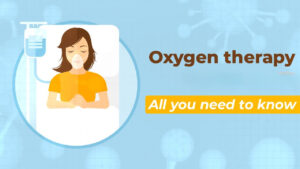Future of Oxygen Therapy: What to Expect in the Coming Decade?
July 31, 2024 2024-08-16 11:12Future of Oxygen Therapy: What to Expect in the Coming Decade?

Future of Oxygen Therapy: What to Expect in the Coming Decade?
Oxygen therapy has long been a cornerstone treatment for individuals with chronic respiratory conditions, acute respiratory distress, and other health issues requiring supplemental oxygen. As technology advances, the landscape of oxygen therapy is poised for significant transformation. In the coming decade, we can expect numerous innovations and improvements that will enhance the efficacy, convenience, and accessibility. Here’s a detailed look at what the future holds.

1. Advancements in Portable Oxygen Concentrators
Portable oxygen concentrators (POCs) have already revolutionized oxygen therapy by providing patients with the freedom to move and travel while receiving their required oxygen. Over the next decade, we can expect POCs to become even more compact, lightweight, and efficient. Advances in battery technology will allow for longer use without recharging, and improved designs will make these devices quieter and more user-friendly.
2. Integration of Smart Technology
Smart technology is set to play a significant role in the future of oxygen therapy. Integration of Internet of Things (IoT) and artificial intelligence (AI) will lead to the development of smart oxygen concentrators that can monitor a patient’s oxygen levels in real-time and adjust the oxygen flow automatically. These devices will be able to sync with smartphones and other digital devices, providing continuous data to both patients and healthcare providers, enabling more precise and personalized care.
3. Telemedicine and Remote Monitoring
The rise of telemedicine will significantly impact oxygen therapy. Remote monitoring systems will allow healthcare providers to track patients’ oxygen levels and device performance in real-time, leading to prompt interventions when necessary. This can be particularly beneficial for patients in remote areas or those with limited access to healthcare facilities. Regular virtual check-ups will become commonplace, ensuring that patients receive timely advice and adjustments to their therapy as needed.
4. Enhanced Oxygen Delivery Systems
Traditional oxygen delivery systems, such as nasal cannulas and face masks, are expected to see significant improvements. Future designs will focus on maximizing comfort and efficiency. Innovations may include more ergonomic and skin-friendly materials, reducing irritation and discomfort during prolonged use. Additionally, advanced flow control mechanisms will ensure that patients receive the optimal amount of oxygen with minimal wastage.
5. Personalized Oxygen Therapy
Personalization will be at the forefront of future oxygen therapy. Using data analytics and AI, healthcare providers will be able to tailor oxygen therapy to the specific needs of each patient. This individualized approach will consider factors such as activity levels, respiratory patterns, and overall health status to adjust oxygen delivery dynamically, ensuring that patients receive the most effective therapy possible.
6. Nanotechnology in Oxygen Delivery
Nanotechnology holds promise for revolutionizing oxygen therapy. Researchers are exploring the use of nanomaterials to enhance the efficiency of oxygen delivery systems. For example, nanoparticles could be used to create more effective filters in concentrators, leading to higher purity oxygen outputs. Additionally, nanotechnology could enable the development of more compact and efficient oxygen storage solutions.
7. Eco-Friendly Oxygen Therapy Solutions
As environmental concerns grow, the healthcare industry is increasingly focusing on sustainability. Future devices will likely incorporate eco-friendly materials and energy-efficient technologies. Innovations may include solar-powered concentrators and biodegradable components, reducing the environmental impact of oxygen therapy.
8. Wireless and Wearable Oxygen Therapy
Wearable technology is another area poised for growth. Future oxygen therapy could involve wearable devices that provide supplemental oxygen discreetly and comfortably. These wearables could be integrated into clothing or accessories, making less obtrusive and more compatible with daily activities. Wireless technology will also allow these devices to connect seamlessly with smartphones and other monitoring systems.
9. Hyperbaric Oxygen Therapy (HBOT) Innovations
Hyperbaric oxygen therapy, which involves breathing pure oxygen in a pressurized environment, is used to treat various medical conditions. Advances in this field may include more portable and accessible HBOT chambers, enabling patients to receive treatment at home or in outpatient settings. Additionally, improved chamber designs and protocols will enhance the safety and effectiveness of HBOT.
10. Addressing the Needs of Diverse Populations
Future innovations will address the unique needs of different populations, including children, the elderly, and individuals with specific medical conditions. Pediatric oxygen therapy devices will be designed to be more comfortable and less intimidating for young patients. For the elderly, devices will focus on ease of use and portability, ensuring that older adults can manage their therapy independently.
11. Regenerative Medicine and Oxygen Therapy
The intersection of regenerative medicine offers exciting possibilities. Researchers are exploring how oxygen therapy can support tissue regeneration and healing in conditions such as chronic wounds and neurological disorders. This approach could lead to new therapeutic protocols that combine oxygen therapy with other regenerative treatments to enhance recovery and improve outcomes.
12. Global Accessibility and Affordability
One of the significant challenges in is ensuring global accessibility and affordability. Future innovations will aim to make oxygen therapy more accessible to underserved populations, particularly in low-income and remote areas. Advances in manufacturing and distribution, coupled with cost-effective technologies, will help bridge the gap and provide life-saving oxygen therapy to those in need.
Conclusion
The future of oxygen therapy is bright, with numerous innovations on the horizon that will enhance the effectiveness, convenience, and accessibility of treatment. From smart technology and personalized care to eco-friendly solutions and wearable devices, the next decade promises significant advancements that will improve the lives of individuals requiring supplemental oxygen. As these technologies evolve, it is crucial to continue focusing on patient-centered care, ensuring that every innovation aligns with the ultimate goal of enhancing health and well-being for all users.



